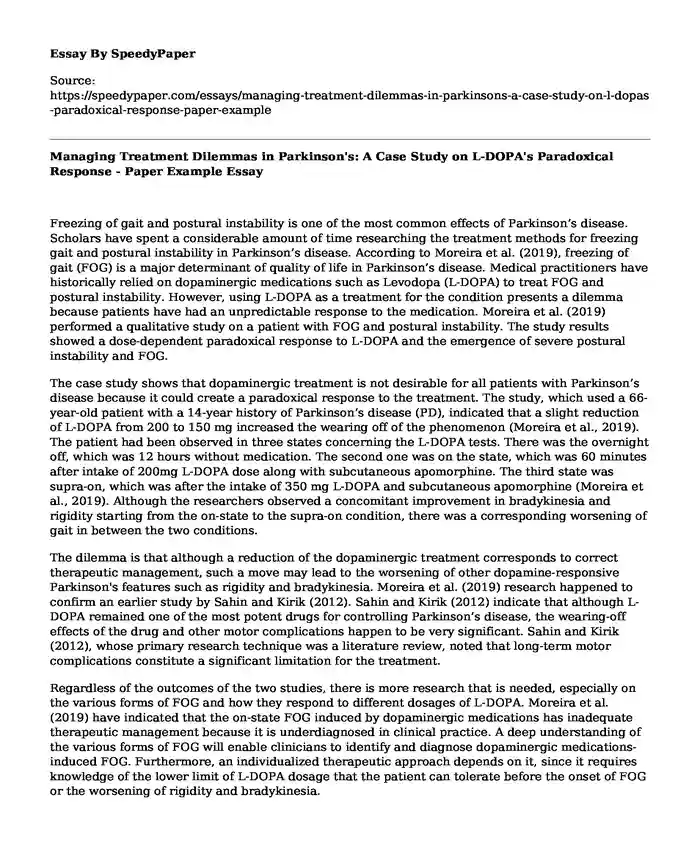
| Type of paper: | Essay |
| Categories: | Health and Social Care Nursing management |
| Pages: | 3 |
| Wordcount: | 702 words |
Freezing of gait and postural instability is one of the most common effects of Parkinson’s disease. Scholars have spent a considerable amount of time researching the treatment methods for freezing gait and postural instability in Parkinson’s disease. According to Moreira et al. (2019), freezing of gait (FOG) is a major determinant of quality of life in Parkinson’s disease. Medical practitioners have historically relied on dopaminergic medications such as Levodopa (L-DOPA) to treat FOG and postural instability. However, using L-DOPA as a treatment for the condition presents a dilemma because patients have had an unpredictable response to the medication. Moreira et al. (2019) performed a qualitative study on a patient with FOG and postural instability. The study results showed a dose-dependent paradoxical response to L-DOPA and the emergence of severe postural instability and FOG.
The case study shows that dopaminergic treatment is not desirable for all patients with Parkinson’s disease because it could create a paradoxical response to the treatment. The study, which used a 66-year-old patient with a 14-year history of Parkinson’s disease (PD), indicated that a slight reduction of L-DOPA from 200 to 150 mg increased the wearing off of the phenomenon (Moreira et al., 2019). The patient had been observed in three states concerning the L-DOPA tests. There was the overnight off, which was 12 hours without medication. The second one was on the state, which was 60 minutes after intake of 200mg L-DOPA dose along with subcutaneous apomorphine. The third state was supra-on, which was after the intake of 350 mg L-DOPA and subcutaneous apomorphine (Moreira et al., 2019). Although the researchers observed a concomitant improvement in bradykinesia and rigidity starting from the on-state to the supra-on condition, there was a corresponding worsening of gait in between the two conditions.
The dilemma is that although a reduction of the dopaminergic treatment corresponds to correct therapeutic management, such a move may lead to the worsening of other dopamine-responsive Parkinson's features such as rigidity and bradykinesia. Moreira et al. (2019) research happened to confirm an earlier study by Sahin and Kirik (2012). Sahin and Kirik (2012) indicate that although L-DOPA remained one of the most potent drugs for controlling Parkinson’s disease, the wearing-off effects of the drug and other motor complications happen to be very significant. Sahin and Kirik (2012), whose primary research technique was a literature review, noted that long-term motor complications constitute a significant limitation for the treatment.
Regardless of the outcomes of the two studies, there is more research that is needed, especially on the various forms of FOG and how they respond to different dosages of L-DOPA. Moreira et al. (2019) have indicated that the on-state FOG induced by dopaminergic medications has inadequate therapeutic management because it is underdiagnosed in clinical practice. A deep understanding of the various forms of FOG will enable clinicians to identify and diagnose dopaminergic medications-induced FOG. Furthermore, an individualized therapeutic approach depends on it, since it requires knowledge of the lower limit of L-DOPA dosage that the patient can tolerate before the onset of FOG or the worsening of rigidity and bradykinesia.
The therapeutic dilemma presented by Parkinson’s disease was examined in three different tests. There were the off-state, the on-state, and supra-on-state. Each of the three states had the patient on varying degrees of dopaminergic medication with off-state representing none and the supra-on representing a high amount of 350 mg L-DOPA (Moreira et al., 2019). The researchers observed increased FOG and postural instability in the on state and worsened in the supra-on state. Unlike the Moreira et al. (2019) study, Sahin and Kirik (2012) only discussed the effects of L-DOPA from a general perspective. According to Sahin and Kirik (2012), patients exhibit an initial satisfactory response to L-DOPA but later develop side effects such as motor fluctuation and significant involuntary movements.
References
Moreira, F., Gomes, I. R., & Januário, C. (2019). Freezing of gait and postural instability: the unpredictable response to levodopa in Parkinson’s disease. BMJ Case Reports CP, 12(7), e229224.
Sahin, G., & Kirik, D. (2012), 26 Efficacy of L-DOPA Therapy in Parkinson’s Disease. and Health, 454. https://www.researchgate.net/profile/Gurdal_Sahin/publication/261251834_Efficacy_of_L-DOPA_therapy_in_Parkinson’ s_disease/links/00b7d533b3715043ec000000/Efficacy-of-L-DOPA-therapy-in-Parkinsons-disease.pdf
Cite this page
Managing Treatment Dilemmas in Parkinson's: A Case Study on L-DOPA's Paradoxical Response - Paper Example. (2023, Nov 14). Retrieved from https://speedypaper.com/essays/managing-treatment-dilemmas-in-parkinsons-a-case-study-on-l-dopas-paradoxical-response-paper-example
Request Removal
If you are the original author of this essay and no longer wish to have it published on the SpeedyPaper website, please click below to request its removal:
- Free Essay on Marijuana Addiction in Youths
- Essay Sample about Government Funding Cuts to Community Pharmacy
- Free Essay: Patients' Medical Condition Assessment, Therapies and Other Interventions
- Comparison Essay Sample: Healthcare System in the U.S. and Japan
- Free Essay Example on Health Promotion and New Zealand's Health Strategy
- Essay Sample on Risk Management of Companies during Covid-19
- Essay on Determining Noise Exposure for Insomnia & Hearing Loss
Popular categories




